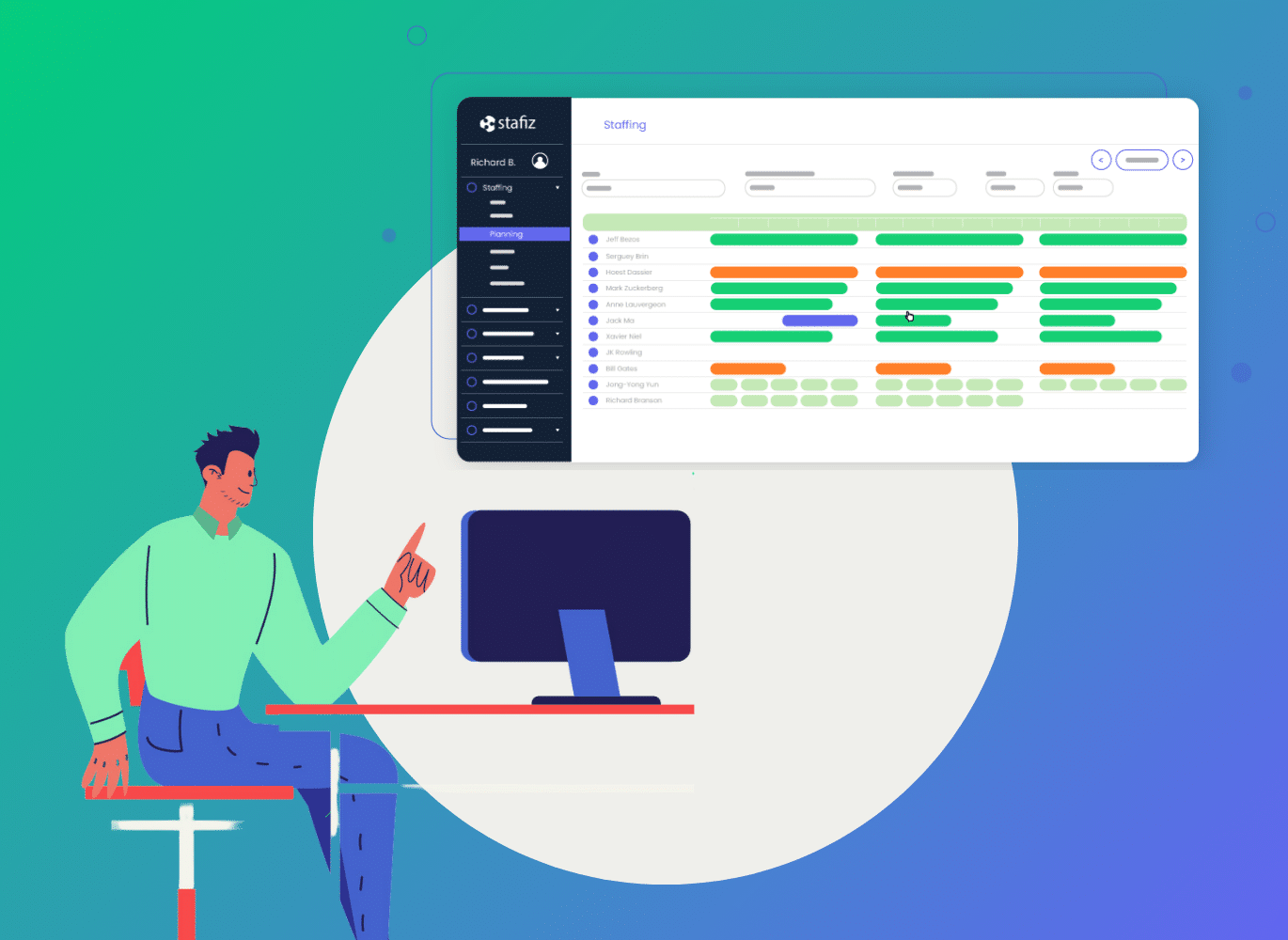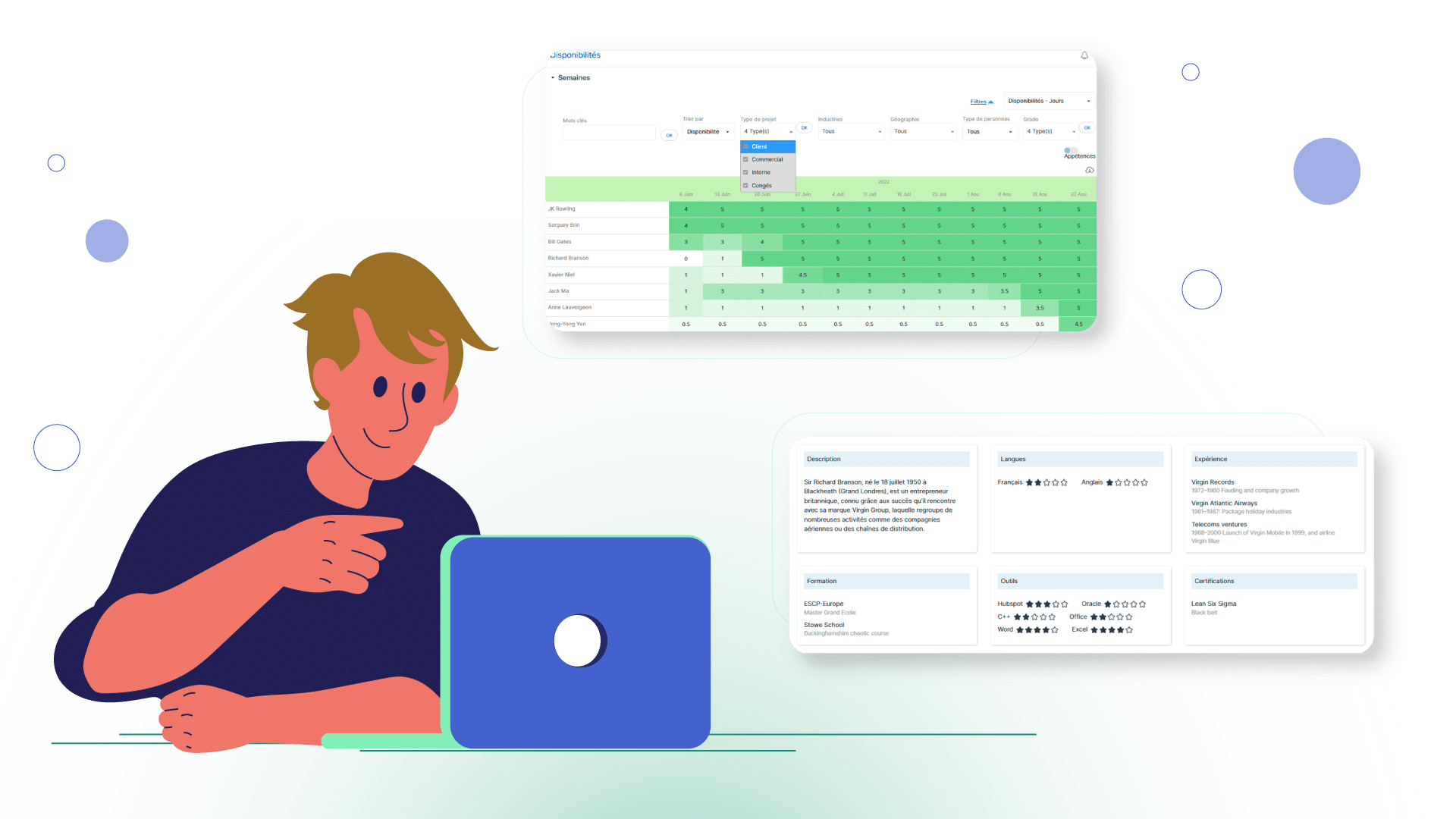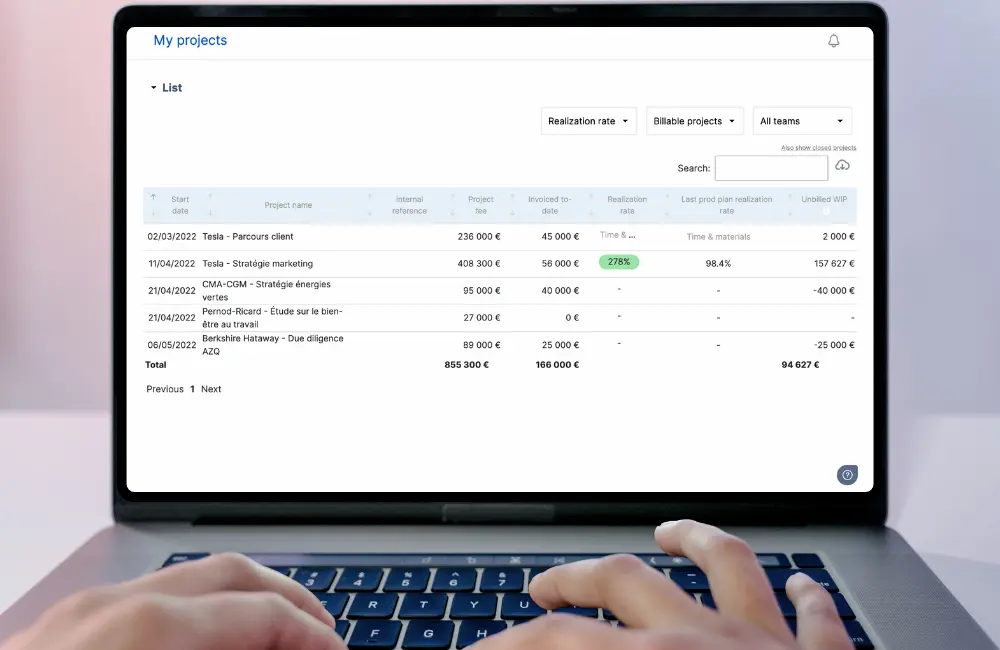What is Billable Utilization Rate and Why It Matters

What is Billable Utilization Rate?
Definition and Formula
✏️ Synonyms of billable utilization rate: utilization rate, resource planning rate.
Billable utilization rate is an HR indicator measuring the rate of activity spent on billable tasks compared to the total availability (excluding periods of leave, sick leave, etc.).
The billable utilization rate is generally expressed as a percentage, and is calculated by dividing the number of hours worked on billable activities by the number of theoretical hours available after deduction of time off.
![]()
It is used by companies, and more particularly by consulting firms and IT Services to evaluate the performance and profitability of employees or teams.
It allows you to make decisions about resource management.
What's the difference between billable utilization rate and utilization rate?
Unlike billable utilization rate, utilization rate takes into account leaves as well as time worked on non-billable tasks.
The utilization rate formula is the following:
![]()
While the utilization rate can vary greatly from one month to another due to holidays, it allows a reading that is closer to invoicing.
For companies that work in a time-based approach (invoicing by time spent), following this indicator helps better understanding a given project's results.
However, this indicator is less widely used in practice than the utilization rate.
Why Choose to Track Billable Utilization Rather Than all Activity?
This approach to billable utilization rate, which measures billable activity, is particularly important in IT Services, consulting firms and agencies. These companies pay their employees' salaries each month, which represent fixed costs.
For the activity to be profitable, it is necessary that each employee spends a certain percentage of his or her time on an activity that is billable, i.e. generates turnover, otherwise the profitability of the activity will not be there.
It is therefore a standard and major indicator for all companies that sell the work of consultants or projects to clients: consulting firms, IT Services, agencies, design offices, architectural firms, chartered accountants, etc.
Why is Billable Utilization Rate so Important in Project Management?
The billable utilization rate as a project performance indicator offers several advantages.
The benefits of billable utilization rate
- Enhancing real productivity
The billable utilization rate measures an employee's activity by taking into account periods not worked. This provides greater reliability in terms of actual activity, and is a better indicator for comparing results.
For example, an indicator that only looks at the number of days produced during a period will penalise the employee who has taken leave during the period in question.
The representation of production by the utilization rate is therefore more objective.
- A sign of an unequal distribution of labour
The billable utilization rate also enables us to identify employees who are overloaded and those who are underloaded. In either case, an uneven workload penalizes productivity.
Overload can lead to a decrease in the quality of work and the well-being of employees. As for underloading, it can lead to a drop in the profitability of the activity and dissatisfaction of the employee, who risks losing interest in his or her missions.
- A benchmark indicator
The rate of resource planning allows performance to be measured over time, since each period is comparable. It then makes it possible to monitor and analyze individual or team productivity according to the types of projects or periods.
It is a valuable source of data for planning future projects, or for improving operational efficiency.
Utilization Rate: What Limits?
However, billable utilization rate as a performance indicator also has its limitations.
- The complexity of monitoring
Without the help of a tool that calculates the billable utilization rate automatically, it's not always possible to differentiate between sales-generating and non-sales-generating activities.
For example, employees may spend time explaining or training other employees, or they may be active in sales activities. We need to be able to measure the time spent on this type of activity, which nevertheless serves the company but should not penalize the billable utilization rate.
Only one Time and time management tool resource planning adapted will allow these calculations to be made automatically.
- An indicator that is not enough on its own
The billable utilization rate does not measure the quality of employees' work or their contribution to achieving the company's objectives.
Performance must be analyzed in conjunction with other indicators that complement the billable utilization rate.
Certain external events, beyond the control of employees, can disrupt the billable utilization rate results. These external factors are not necessarily taken into account when readjusting the results, and penalize the reading of employee performance.
- An indicator not well suited to fixed-price sales
In the context of a project sold at a fixed price regardless of the work carried out, the billable utilization rate lacks relevance.
If an employee spends 100% of his time on a customer project, but makes little progress on his tasks, he will have a high billable utilization rate, even if the project is likely to fall behind schedule.
This is a situation that billable utilization rate is unable to read.
- A potentially burdensome performance race
The billable utilization rate can push employees to work harder to meet targets, even though they are overloaded.
This not only risks producing more low-quality work, but also, in the worst case, putting their health or well-being at risk.
What factors can affect the staff activity rate?
There are many reasons why utilization rate do not meet the objectives.
- Inefficient processes: if employees waste time on non-productive tasks - such as administration, work reporting or project travel- their output will suffer, and their billable utilization rate will be lower than expected.
- Insufficient capacity: if the workforce is underloaded, production will also be below the total theoretical capacity available. The billable utilization rate is unlikely to meet its targets.
- Poor time management: if employees manage their time poorly and spend too much time on non-billable tasks, the billable utilization rate will be impacted.
What is the average billable utilization rate in a consulting firm?
The standard staff activity rate vary greatly depending on the industry and the profession carried out. It is therefore relevant to calculate the staff activity rate for each employee, but also to be able to consolidate them by type of profile or by type of activity.
The billable utilization rate of a full-time consultant working for one customer for one year will thus be much higher than that of a manager in charge of several projects.
The latter will spend time managing teams, perhaps selling other projects to the customer. His billable utilization rate target should therefore be lower, so as not to penalize him.
On average, successful consulting companies have the staff activity rates of around 70 to 75%. However, this figure varies, and the most junior profiles display the staff activity rates close to 75% to 85% while the most senior profiles are around 60 to 65%.
How do you interpret the billable utilization rate in the workplace?
The billable utilization rate results need to be read from different angles.
- Comparison of actual billable utilization rate with targets
To set a course, it is important to define an annual or monthly billable utilization rate target when the business cycle has a significant impact on this indicator.
We then need to monitor the deviation of actual billable utilization rate from target, and understand the reason for these deviations in order to improve future production.
- Comparing the billable utilization rate of one team to another
It's interesting to take the billable utilization rate analysis a step further by grouping utilization rate by profile type, or by team type.
This makes it possible to benchmark the performance of a group and to set objectives at the level of a team manager
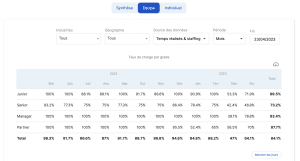
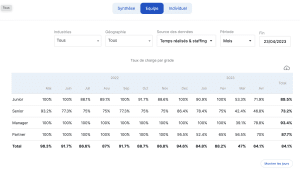
- Follow the utilization rate forecast
This exercise makes it possible to anticipate variances in order to adjust the planning to achieve the objective.
When monitoring allows it, the billable utilization rate is not just an indicator looked at in the past. It can also be used to take the temperature of the load forecast for the coming months.
How can the billable utilization rate be improved in a service company?
The key toimproving the billable utilization rate lies in better mastery of the resource planning (or capacity planning) management process.
The more accurate the visibility into the forecast load , the more managers will have the ability to optimize production and improve throughput rates. resource planning.
The importance of communicating around the staff activity rate
Once the billable utilization rate calculations have been put in place, the work doesn't stop with monitoring by management or management control. We need to make the billable utilization rate a performance indicator that is understood and monitored by all our employees, so that they can appreciate what's at stake.
You can train them to explain why and how to track this indicator.
It is important to be educational to make it clear that it is not a question of monitoring the employee but of improving the overall performance of the activity.
Next, we need to make the tracking available to every employee and manager who has a billable utilization rate target. They need to be able to easily read the updated billable utilization rate, in real time, according to the activity that has been confirmed.
The more reliable and transparent the calculation, the more employees will monitor this indicator and contribute to its improvement.
Using the right tools to monitor the billable utilization rate
Using a resource planning tool such as Stafiz to manage forecasted workloads, reduce inter-contracting and gain visibility over forecasted schedules is essential. This is by far the easiest way to improve a company's billable utilization rate.
Stafiz makes it possible to track the billable utilization rate of past projects, in real time, and to gain visibility over the forecast. This makes it easier to identify opportunities that correspond to different profiles, and avoid cross-contracting.
Finally, they provide the visibility needed to adjust recruitment policies, and always optimize capacity in relation to demand. Better anticipating overload and underload implies clearer recruitment policies, at the right time.
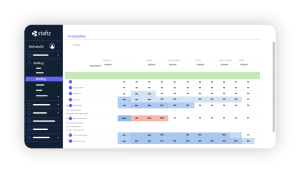
Discover Stafiz, the management tool for resource planning complete and predictive for your teams. Gain in performance while satisfying your employees thanks to optimal management.
Project resource planning software
Simplifying processes
Work to simplify processes for employees who work on billable projects.
The organization must be overhauled to reduce the time spent on non-billable tasks as much as possible and allow employees to focus their work on billable activities
For IT Services : reduce the inter-contract period
By systematically reducing the number of intercontracts, billable utilization rate can be improved.
To do this, we need to have more visibility on the risk of inter-contract and the options for relocating employees.
To do this, set up smart alerts that warn you when an employee is about to go on an inter-contract to try to place them on another billable project.
Ideally, your resource planning tool gives you the visibility you need into upcoming availability and which projects are close to being won. This helps you to find out more easily which opportunities correspond to employees on inter-contract to reposition them.
